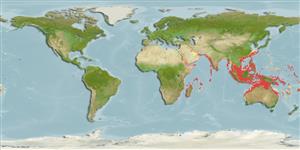Environment: milieu / climate zone / depth range / distribution range
экология
морской; солоноватоводный ассоциированный с рифами; амфидромный (Ref. 51243); пределы глубины 0 - 150 m (Ref. 5222). Tropical; 30°N - 32°S, 29°E - 173°W (Ref. 5222)
Indo-Pacific: Red Sea and East Africa to Tonga, north to Japan, south to Australia. It is not known from the Persian Gulf, where the closely related Epinephelus coioides is common.
Length at first maturity / Size / Вес / Возраст
Maturity: Lm 64.0 range ? - ? cm
Max length : 234 cm TL самец/пол неопределен; (Ref. 5213); common length : 100.0 cm TL самец/пол неопределен; (Ref. 5213); наибольший вес (опубликованные данные): 150.0 kg (Ref. 9710)
колючие лучи спинного плавника (общее число) : 11; членистые (мягкие) лучи спинного плавника (общее число) : 14 - 16; колючие лучи анального плавника: 3; членистые (мягкие) лучи анального плавника: 8. Characterized by light grey to yellowish brown color; five slightly oblique dark brown bars that bifurcate ventrally; numerous small black spots and blotches in head and body; ctenoid scales on body except cycloid anterodorsally on body, thorax and abdomen; body with auxiliary scales; greatest depth of body 3.0-3.6 in SL; rounded caudal fin; pelvic fins, 2.0-2.6 in head length (Ref. 90102); head length 2.3-2.6 times in SL; snout length 1.7-2.0 times in upper jaw length; interorbital width 4.5-6.5 times in HL and 2.1-3.0 times in upper jaw length; flat or slightly convex interorbital area; subangular preopercle, with enlarged serrae at the angle; almost straight upper edge of operculum; subequal posterior and anterior nostrils, except in large adults which have the posterior nostrils slightly larger; maxilla reaches to or past vertical at rear edge of orbit, maxilla width 4.5-6.5% of SL; upper jaw length 17-22% of SL, 2-5 rows of teeth on midlateral part of lower jaw (Ref. 89707).
A common species found in a variety of habitats: coral and rocky reefs, tide pools, estuaries, mangrove swamps and sandy or mud bottom from shore to depths of 150 m. Solitary (Ref 90102). Juveniles found near shore and in estuaries; sex reversal probable; catch statistics poor being previously confused with E. andersoni (Ref. 4332). Feed primarily on fishes and crustaceans, and occasionally on cephalopods (Ref. 9710). Present in Hong Kong live fish markets (Ref. 27253). Widely used in mariculture mainly in the Far East (Ref. 43448).
Heemstra, P.C. and J.E. Randall, 1993. FAO Species Catalogue. Vol. 16. Groupers of the world (family Serranidae, subfamily Epinephelinae). An annotated and illustrated catalogue of the grouper, rockcod, hind, coral grouper and lyretail species known to date. Rome: FAO. FAO Fish. Synop. 125(16):382 p. (Ref. 5222)
Статус Красного Списка МСОП (Ref. 130435: Version 2024-1)
Угроза для людей
Harmless
Использование человеком
рыболовство: важный объект промысла; аквакультура (рыбоводство): коммерческий; объект спортивного рыболовства: да
дополнительная информация
инструменты
Специальные отчеты
Скачать в формате XML
ресурсы в Интернет
Estimates based on models
Preferred temperature (Ref.
123201): 24.3 - 29.1, mean 28 °C (based on 2428 cells).
Phylogenetic diversity index (Ref.
82804): PD
50 = 0.5000 [Uniqueness, from 0.5 = low to 2.0 = high].
Bayesian length-weight: a=0.01230 (0.00803 - 0.01885), b=3.05 (2.93 - 3.17), in cm total length, based on LWR estimates for this species & Genus-body shape (Ref.
93245).
Trophic level (Ref.
69278): 4.2 ±0.50 se; based on food items.
Generation time: 1.4 ( na - na) years. Estimated as median ln(3)/K based on 1
growth studies.
устойчивость к внешним воздействиям (Ref.
120179): низкий, минимальное время удвоения популяции 4.5-14 лет (Fec = 51,087).
Fishing Vulnerability (Ref.
59153): Moderate vulnerability (40 of 100).
Nutrients (Ref.
124155): Calcium = 16.4 [6.8, 35.7] mg/100g; Iron = 0.497 [0.220, 1.121] mg/100g; Protein = 19.6 [17.9, 21.1] %; Omega3 = 0.129 [0.065, 0.254] g/100g; Selenium = 75.1 [32.6, 184.0] μg/100g; VitaminA = 33.9 [6.3, 185.3] μg/100g; Zinc = 0.838 [0.516, 1.355] mg/100g (wet weight);
